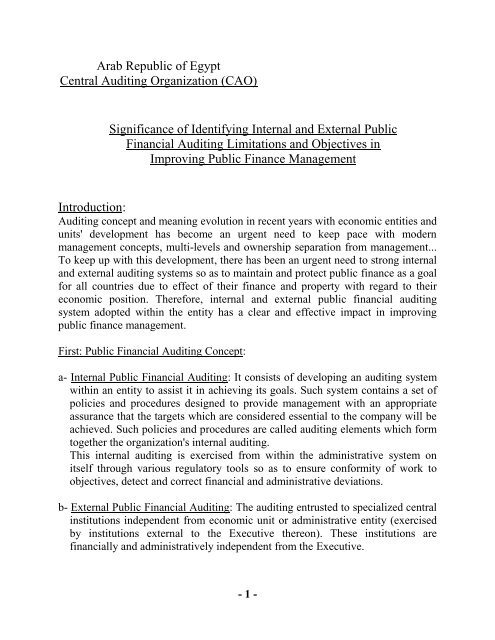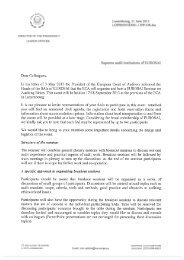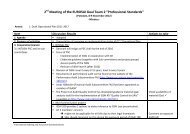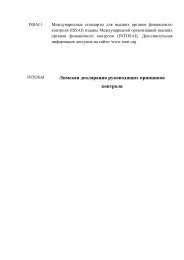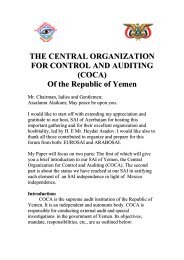Arab Republic of Egypt Central Auditing Organization (CAO) - Eurosai
Arab Republic of Egypt Central Auditing Organization (CAO) - Eurosai
Arab Republic of Egypt Central Auditing Organization (CAO) - Eurosai
Create successful ePaper yourself
Turn your PDF publications into a flip-book with our unique Google optimized e-Paper software.
<strong>Arab</strong> <strong>Republic</strong> <strong>of</strong> <strong>Egypt</strong><br />
<strong>Central</strong> <strong>Auditing</strong> <strong>Organization</strong> (<strong>CAO</strong>)<br />
Significance <strong>of</strong> Identifying Internal and External Public<br />
Financial <strong>Auditing</strong> Limitations and Objectives in<br />
Improving Public Finance Management<br />
Introduction:<br />
<strong>Auditing</strong> concept and meaning evolution in recent years with economic entities and<br />
units' development has become an urgent need to keep pace with modern<br />
management concepts, multi-levels and ownership separation from management...<br />
To keep up with this development, there has been an urgent need to strong internal<br />
and external auditing systems so as to maintain and protect public finance as a goal<br />
for all countries due to effect <strong>of</strong> their finance and property with regard to their<br />
economic position. Therefore, internal and external public financial auditing<br />
system adopted within the entity has a clear and effective impact in improving<br />
public finance management.<br />
First: Public Financial <strong>Auditing</strong> Concept:<br />
a- Internal Public Financial <strong>Auditing</strong>: It consists <strong>of</strong> developing an auditing system<br />
within an entity to assist it in achieving its goals. Such system contains a set <strong>of</strong><br />
policies and procedures designed to provide management with an appropriate<br />
assurance that the targets which are considered essential to the company will be<br />
achieved. Such policies and procedures are called auditing elements which form<br />
together the organization's internal auditing.<br />
This internal auditing is exercised from within the administrative system on<br />
itself through various regulatory tools so as to ensure conformity <strong>of</strong> work to<br />
objectives, detect and correct financial and administrative deviations.<br />
b- External Public Financial <strong>Auditing</strong>: The auditing entrusted to specialized central<br />
institutions independent from economic unit or administrative entity (exercised<br />
by institutions external to the Executive thereon). These institutions are<br />
financially and administratively independent from the Executive.<br />
- 1 -
Second: Public Financial <strong>Auditing</strong> Types:<br />
a- Internal Public Financial <strong>Auditing</strong> Types:<br />
Internal public financial auditing is divided into three main sections, namely:<br />
1- Management Control: It includes hierarchy, procedures and records particular<br />
to decisional operations that lead to adoption and approval <strong>of</strong> operations by<br />
management so as to achieve entity's objectives that are indirectly connected<br />
to financial and accounting records, i.e., management control seeks to raising<br />
maximum productivity by following-up performance and compliance to<br />
management policies.<br />
2- Accounting control: It endeavors to provide appropriate accuracy <strong>of</strong><br />
accounting data and information contained in books and records and to<br />
achieve the target by adopting specific accounting systems, e.g., double-entry<br />
method, monthly trial balances, constant inventory system with availability <strong>of</strong><br />
sound documentation and internal audit system.<br />
3- Internal Monitoring: Internal monitoring is a branch <strong>of</strong> auditing particular to<br />
scrutinizing and protecting the entity's assets, resources and property against<br />
misappropriation, loss or theft through work division and distribution,<br />
competencies and responsibilities identification where each employee<br />
automatically reviews another employee's work without duplication <strong>of</strong> their<br />
respective work. It is conducted through proper administrative division,<br />
identification <strong>of</strong> centers for authority and responsibility, relationship<br />
coordination between various departments which illustrates rules and<br />
regulations governing work progress within each department and designing an<br />
integrated accounting system that leads to achieve the objective if this system<br />
properly operated.<br />
We can identify, from the above-mentioned, that internal auditing is not, in<br />
aggregate, limited to book-keeping and accounting aspects, but includes the<br />
technical and administrative system. For conducting its duty, the institution<br />
must be divided into departments where no single department is entrusted<br />
with all types <strong>of</strong> operations. Work should be divided between departments<br />
where they monitor, as much as possible, each other's work results without<br />
work duplication in order that work progresses in various departments in full<br />
harmony towards common interest.<br />
- 2 -
- External Public Financial <strong>Auditing</strong>:<br />
External (specialized) auditing institutions performance evolved as they are no<br />
longer confined to censorship and inspection, they, rather, extended to all aspects<br />
affecting socio-economic and environmental equilibrium and removing obstacles<br />
particular to research, study and analysis, and they may conduct the following:<br />
1- Financial auditing in both its accounting and legal aspects.<br />
2- Performance auditing, following-up plan implementation and results evaluation.<br />
3- Legal auditing on decisions particular to financial irregularities.<br />
Third: Internal & External Public Financial <strong>Auditing</strong> Objectives & Significance:<br />
a- Internal <strong>Auditing</strong> Objectives:<br />
Internal auditing objective have initially been limited to detection <strong>of</strong> errors, fraud<br />
and manipulation, and as a result <strong>of</strong> time evolution, internal auditing objectives<br />
have developed and are summarized in the following:<br />
- Determine financial and operational information accuracy and reliability.<br />
- Identify institution risks and reduce them to the minimum level.<br />
- Verify adoption <strong>of</strong> internal procedures and policies and external laws and<br />
regulations.<br />
- Satisfy the established criteria.<br />
- Efficient and effective use <strong>of</strong> resources.<br />
- Help members <strong>of</strong> the organization to carry out their responsibilities efficiently<br />
and effectively.<br />
* Internal <strong>Auditing</strong> Significance:<br />
internal auditing is significant as an effective control that helps the firm's<br />
management and owners to promote business quality and performance evaluation,<br />
maintain the firm's property and assets, beside being as the external auditor's visual<br />
and auditory systems and the most important institutional control mechanisms.<br />
Therefore, it has emerged, evolved and increased in significance as a result <strong>of</strong> a<br />
combination <strong>of</strong> factors, namely:<br />
1- Magnitude <strong>of</strong> firms and their operations multiplicity.<br />
2- Necessity for management to delegate authorities and responsibilities to some<br />
sub-departments within the firm.<br />
3- The firm's management need to regular and accurate data for policy-making,<br />
planning and decision-taking.<br />
4- The firm's management need to protect and safeguard the firm's assets against<br />
fraud, theft and errors.<br />
- 3 -
5- Governmental and other agencies' need to accurate data for economic planning,<br />
public control, and pricing.<br />
6- Internal auditing procedures evolution from full details to testing based on<br />
method <strong>of</strong> statistical sampling.<br />
b- External <strong>Auditing</strong> Objectives:<br />
External auditing seeks to achieve several objectives, including:<br />
- Principal objectives:<br />
External auditing main objectives are represented in the following:<br />
1- External auditing process seeks principally to express an impartial pr<strong>of</strong>essional<br />
opinion on financial statements' fair representation for result <strong>of</strong> operation and<br />
financial position, according to the generally-accepted accounting principles.<br />
2- It provides the firm's management with information on internal auditing system<br />
and identifies its deficiencies through recommendations presented by the auditor<br />
in his report to improve system performance.<br />
3- It provides financial statements users, i.e., investors, creditors, banks, concerned<br />
government departments and other entities with reliable financial statements, to<br />
help them take appropriate decisions.<br />
- Specific objectives:<br />
The above-mentioned objectives are external auditing principal targets. In order to<br />
achieve those goals, the auditor should primarily satisfy sub-goals, which are the<br />
six objectives related to financial statement account balances examination. These<br />
objectives are used as intermediary targets, form a link between auditing standards<br />
and procedures, and are represented as follows:<br />
1- Verification <strong>of</strong> presence, i.e., assets, liabilities and commitments already exist at<br />
a certain date.<br />
2- Verification <strong>of</strong> completion, i.e., all assets, liabilities, expenses and revenues<br />
have perfectly been entered in books and records, and that there is no nonregistered<br />
operations.<br />
3- Verification <strong>of</strong> ownership, i.e., all assets and property are owned by the firm at a<br />
particular date, liabilities or obligations represent a real commitment to the firm<br />
at a particular date.<br />
4- Verification <strong>of</strong> assessment, i.e., assets and liabilities have been evaluated and<br />
recorded at their convenient value.<br />
- 4 -
5- Verification <strong>of</strong> financial statements true and fair presentation, i.e., all financial<br />
statement components have properly been disclosed and presented in accordance<br />
with the relevant legal and pr<strong>of</strong>essional requirements.<br />
6- Verification <strong>of</strong> financial operations legality and validity, i.e., values <strong>of</strong> all assets,<br />
liabilities, expenses and revenues have accurately been calculated and approved<br />
by the legally competent authority in accordance with requirements <strong>of</strong> valid<br />
laws, regulations and systems, and fulfilled the <strong>of</strong>ficial purposes and works<br />
which achieved their goals.<br />
* External <strong>Auditing</strong> Significance:<br />
External auditing appear as a means to serve many groups who heavily rely on<br />
financial statements approved by the independent external auditor, in order to meet<br />
their vast heterogeneous information requirements, which vary according to their<br />
different interests and objectives. These groups are as follows:<br />
1- Management and Board <strong>of</strong> Directors' members: The auditor's report focuses<br />
principally on obtaining information that will enable them to review<br />
performance and evaluate reporting on complex financial operations beside<br />
taking decisions that affect the firm's future directions.<br />
2- Shareholders: They seek to obtain information so as to enable them to hold<br />
management and staff accountable and to take decisions related to increasing,<br />
decreasing or maintaining the current investment ratio.<br />
3- Current and potential bondholders: This category requires information to help<br />
them assess the firm's degree <strong>of</strong> risk and solvency.<br />
4- Employees and labor unions: They require information to enable them to assess<br />
pr<strong>of</strong>itability, estimate future wages and negotiate on pr<strong>of</strong>it sharing agreements.<br />
5- Economists and scientific researchers: They require information to help them<br />
assess effects concerning economic policies and public policy decisions, assist in<br />
researches and studies. Economists also rely on the audited financial statements<br />
in their estimation <strong>of</strong> national income and economic planning.<br />
6- Customers, suppliers and competitors: This category requires information<br />
approved by the external auditor so as to enable them to evaluate the firm's<br />
"going concern" as a source <strong>of</strong> goods and services or as consumer there<strong>of</strong>, and<br />
assess the firm's competitiveness.<br />
7- Environmental protection advocates and institutions: They require information<br />
to help them assess the environmental damage resulting from practicing the<br />
firm's activity.<br />
- 5 -
8- Governmental agencies: Some State agencies rely on the firms' data approved<br />
by an independent auditor in a variety <strong>of</strong> purposes, including: monitoring<br />
economic activity, formulating the State economic policies or imposing taxes.<br />
9- Judicial system: It requires information to help in evaluating the firm's financial<br />
position for the purposes <strong>of</strong> bankruptcy, assets assessment, and litigation.<br />
10- Consultants, e.g., financial analysts and investment houses: This category<br />
requires information to help them assess the firm's financial position in order to<br />
express advice and guidance to investors.<br />
11- Creditors and banks: Information approved by the independent external auditor<br />
helps this category in determining to what extent the firm can be granted loans,<br />
as well as determining the amount <strong>of</strong> loan and its terms and conditions.<br />
12- Potential investors: They require information to help them take decisions about<br />
the firm's investment potential and determine the appropriate investment rate so<br />
as to achieve the maximum return.<br />
Fourth: Internal and External Finance Management's Complementary Relationship:<br />
There are cooperation and integration between internal auditor (who represents<br />
internal finance management) and external auditor (who represents external<br />
finance management) as they take advantage <strong>of</strong> each other's work, but to varying<br />
degrees – i.e., external auditor reliance on internal auditor's work is higher than the<br />
vice-versa. This integration is represented in the external auditor's aspects <strong>of</strong><br />
reliance on internal auditor's work. We should, for being fair and equitable,<br />
highlight the integration represented in the external auditor's aspects <strong>of</strong> reliance on<br />
internal auditor's work. These aspects are multiple and can be shown is the<br />
following:<br />
1- To achieve auditing maximum effectiveness with regard to broader coverage <strong>of</strong><br />
the firm's financial activities, the internal auditor coordinates his work with the<br />
external auditor's so as to ensure that internal audits <strong>of</strong> the firm's financial<br />
activities complement external auditor's efforts and to eliminate duplication<br />
there<strong>of</strong>. The internal auditor may also seek behind such coordination to identify<br />
audit cost that can be provided.<br />
2- Internal auditor takes advantage <strong>of</strong> external auditor's expertise as the latter is<br />
<strong>of</strong>ten more qualified and experienced as a result <strong>of</strong> the following indicators:<br />
- Workers with external auditor have a high degree <strong>of</strong> scientific and practical<br />
qualification.<br />
- External auditor has specialized skills in the area <strong>of</strong> risk management and<br />
systems design.<br />
- 6 -
- He has specialists, in addition to technical expertise, with regard to certain<br />
industries auditing.<br />
- He works according to the high-quality international standards.<br />
- He has extensive experience in internal audit.<br />
- He uses sophisticated information systems.<br />
- He has a deep-rooted pr<strong>of</strong>essional morals inherent within the pr<strong>of</strong>ession.<br />
Internal auditor can know - through his cooperation with external auditor during<br />
external auditing tasks implementation as well as having access to auditing<br />
program and reports - the new various methods, ideas, information and<br />
procedures adopted by external auditor, and thus takes advantage <strong>of</strong> them in<br />
promoting his efficiency and expertise in the firm's internal auditing.<br />
3- When the external auditor implements audit, his work operations include<br />
internal audit function evaluation, to determine its effectiveness and efficiency<br />
in carrying out its tasks. He highlights through this evaluation any deficiencies<br />
that may appear in its field <strong>of</strong> work and proposes appropriate treatments.<br />
Therefore, such evaluation process gives advantage to internal auditor in<br />
continuous development and improvement <strong>of</strong> his work.<br />
4- External auditor's possession <strong>of</strong> full independence creates an urgent need for<br />
internal auditor's deprivation <strong>of</strong> full independence. Thus, external auditor shall<br />
implement auditing procedures with full independence that enable him to<br />
explicitly and obviously express his opinion concerning internal auditing system<br />
soundness and adopted policies and procedures' appropriateness. Therefore, it<br />
benefits internal auditor in highlighting aspects that he may have overlooked or<br />
could not have explicitly and obviously expressed his opinion therein due to his<br />
limited independence or to other reasons.<br />
5- He achieves legalization and confidence in the firm's financial statements. Thus,<br />
auditing and endorsing the firm's financial statements by its internal auditor is<br />
insufficient to achieve legalization and confidence unless they are audited and<br />
endorsed by an independent external auditor, particularly if they are intended for<br />
third parties, e.g., banks for borrowing or the public for issuance <strong>of</strong> new shares<br />
or bonds .<br />
6- Internal auditor also takes advantage <strong>of</strong> external auditor in understanding<br />
external audit objectives, learning international standards <strong>of</strong> accounting and<br />
auditing and any new versions or modifications there<strong>of</strong>, which facilitates the<br />
way for him to be more specialized. For example, during internal auditor and<br />
external auditor's discussion <strong>of</strong> the firm's balance sheet, the external auditor may<br />
object to the method <strong>of</strong> presenting the firm's assets in the balance sheet, because<br />
it is contrary to what is stipulated in accounting standards in this aspect. Such an<br />
objection undoubtedly helps internal auditor to promote his understanding <strong>of</strong> the<br />
international standards <strong>of</strong> accounting and auditing.<br />
- 7 -
7- The Board <strong>of</strong> Directors may order internal auditor to evaluate external auditor<br />
performance, to achieve the Board <strong>of</strong> Directors' purpose sought by such<br />
evaluation. In this case, the internal auditor will not be able to carry out such<br />
evaluation unless he coordinated between his work and the external auditor's<br />
operations and find a basis and a method <strong>of</strong> communication with external<br />
auditor. Therefore, internal auditor should adopt a specific method to<br />
communicate with external auditor with regard to specific matters that external<br />
auditor may have to discuss with the firm's Board <strong>of</strong> Directors, in order to reach<br />
a general understanding <strong>of</strong> these matters before being discussed with the firm's<br />
Board <strong>of</strong> Directors. These matters include the following:<br />
- Significant weaknesses in internal auditing system.<br />
- Errors and irregularities.<br />
- Significant accounting estimates.<br />
- Significant adjustments resulting from audits.<br />
- Difficulties faced by external auditor in his work.<br />
8- There is occasionally a disagreement between internal auditor and the firm's<br />
financial department about soundness <strong>of</strong> certain accounting procedures<br />
application by the firm's financial department. The two parties may not reach an<br />
agreement there<strong>of</strong>. In such case, the two parties may decide to refer the<br />
disagreement to the external auditor for determination. Internal auditor may also<br />
rely on external auditor per se to help him in solving any problem during his<br />
tasks implementation, particularly if the external auditor is more qualified and<br />
experienced in auditing.<br />
Such integration can be achieved through the following:<br />
Aspects <strong>of</strong> integration and cooperation between internal auditor and external<br />
auditor are extensive and available. This integration has undoubtedly been<br />
achieved only through a combination <strong>of</strong> methods. These methods has been<br />
addressed by standards <strong>of</strong> internal auditing pr<strong>of</strong>essional practice, as they defined<br />
them in the following four methods:<br />
1- Periodic meetings between internal auditor and external auditor to discuss<br />
matters <strong>of</strong> common interest.<br />
2- Having access to each other's audit programs and worksheets.<br />
3- Exchange <strong>of</strong> reports and management letters.<br />
- 8 -
4- Exchange <strong>of</strong> experiences, techniques and knowledge.<br />
These methods shall be explained in the following paragraphs:<br />
1- Periodic Meetings between Internal Auditor and External Auditor to Discuss<br />
Matters <strong>of</strong> Common Interest:<br />
These meetings discuss, for example, internal auditor's plan <strong>of</strong> action and<br />
external auditor's plan <strong>of</strong> action to coordinate operations in order to ensure audit<br />
coverage for the firm's all activities, prevent work duplication and facilitate<br />
exchange <strong>of</strong> technical information pertinent to activity's efficiency. They inform<br />
each other <strong>of</strong> any information or matters discovered during their tasks<br />
implementation that have a significant impact on the other's work.<br />
Those meetings must be scheduleed during auditing to ensure better<br />
coordination, efficient and timely completion <strong>of</strong> audits and to determine whether<br />
audit findings and conclusions require adjustments in the scope <strong>of</strong> planned work<br />
2- Having Access to Each Other's Audit Programs and Worksheets:<br />
It is one <strong>of</strong> the most significant methods to achieve integration between internal<br />
auditor work and external auditor work where each <strong>of</strong> them can learn the other's<br />
techniques, procedures and scope <strong>of</strong> work and understand the level <strong>of</strong><br />
experience and skill possessed by the other party. Therefore, both parties<br />
coordinate their work, reassure comprehensive auditing coverage and decide to<br />
what extent he shall rely on the other's work.<br />
To ensure effective integration through this method, the external auditor should<br />
have reasonable conviction and acceptance <strong>of</strong> the internal auditor's programs<br />
and worksheets and the internal auditor should have reasonable conviction and<br />
acceptance <strong>of</strong> the external auditor's programs and worksheets.<br />
3- Exchange <strong>of</strong> Reports and Management Letters:<br />
Through this method, both internal auditor and external auditor can adjust his<br />
scope <strong>of</strong> work based on the other's report. In addition, internal auditor needs to<br />
understand and accept the firm's management letters sent to external auditor, as<br />
the matters discussed in management letters help internal auditor in planning<br />
areas <strong>of</strong> internal auditor work's concern in the coming period. After examining<br />
management letters and starting any corrective action required by members <strong>of</strong><br />
management and Board <strong>of</strong> Directors, the internal auditor must ensure that the<br />
corrective action has been done.<br />
- 9 -
4- Exchange <strong>of</strong> Experiences, Techniques and Knowledge:<br />
Through this method, both internal auditor and external auditor can successfully<br />
communicate, coordinate and achieve effective integration between their work,<br />
which is reflected on their objectives implementation efficiently and effectively,<br />
and thus achieve the firm's best possible outcomes. The most significant <strong>of</strong> these<br />
outcomes are represented in the firm progress and success in achieving its<br />
predetermined objectives.<br />
Examples <strong>of</strong> exchanging experiences, techniques and knowledge between<br />
internal auditor and external auditor include the following:<br />
a- Internal audit manager must ensure that external auditor's methods,<br />
techniques and terminology are sufficiently understood by internal auditors, to<br />
enable him to:<br />
- Evaluate external auditor's work for the purpose <strong>of</strong> its reliability.<br />
- Ensure that "internal auditors who perform work that achieves external audit<br />
objectives" can effectively communicate with external auditor.<br />
b- Internal audit manager must provide sufficient information to enable external<br />
auditors to understand internal auditors' tools, techniques and terminology so<br />
as to facilitate their reliance on the work performed by internal auditors.<br />
In addition to the above-mentioned methods <strong>of</strong> achieving integration, there is<br />
another method which is considered very significant to promote and increase<br />
degree <strong>of</strong> integration between internal auditor and external auditor, i.e., shared<br />
file, where internal auditor and external auditor can more effectively<br />
coordinate their work, in addition to increasing their reliability on each other's<br />
work.<br />
The shared file shall contain the following:<br />
- System flowcharts.<br />
- Internal auditing policies and procedures.<br />
- <strong>Auditing</strong> programs and worksheets.<br />
- Reports prepared by internal auditors and external auditors that contain<br />
weaknesses and auditing changes.<br />
- 10 -
From the above-mentioned discussion, we conclude that the two types <strong>of</strong> financial<br />
auditing seek mainly to improve and develop financial management performance<br />
so as to ensure the optimal and effective use <strong>of</strong> public finances, effectiveness <strong>of</strong><br />
decisions taken by the competent authorities, that emphasizes the need for effective<br />
accounting system in this regard and providing the necessary information that can<br />
be relied upon in preparing financial reports which are useful to decision makers.<br />
In addition to the requirements <strong>of</strong> creating an effective internal auditing system<br />
which is reliable to prevent or reduce incidence <strong>of</strong> errors, manipulation, fraud and<br />
treating the situation by taking the appropriate decision. They all realize internal<br />
and external public financial management integration, for improving public<br />
financial management which is desired in accordance with the international and the<br />
<strong>Egypt</strong>ian standards <strong>of</strong> accounting.<br />
<strong>CAO</strong>'s Deputy-Chairman<br />
Signature: Mona Al-Mallakh<br />
"Accountant: Mona Al-Mallakh Kamal Al-Mallakh"<br />
- 11 -


